Christopher Gardner and Başak Gardner
Bloomsbury Wildlife, October 2019
READ, TRAVEL & BOTANISE FROM AN ARMCHAIR
This book is magnificent, beautiful, and hugely informative, a work of scholarship and love. No praise too high. I was seduced even before plunging in. The cover transported me to the far tip of the island of Rhodes in Greece where on a golden September visit years ago I first saw clumps of flowering Pancratium maritimum nodding in remote dunes, their heady scent floating on the breeze; and more recently extensive plants cordoned off on Plakias beach in south western Crete on one of MPG’s happy visits led by the Crete flora guru John Fielding.
However, a further image hints politely at this single coastal species’ typical plight, for in far view are pretty umbrellas and an evidently fried human head poking over a sun lounger.
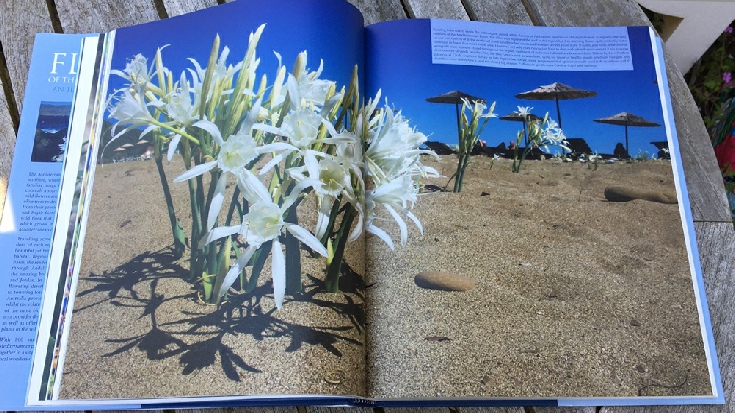
We may love a sandy beach, but we hold our collective breath that future developments give these and other floral beauties a breather. Still, maybe a rare positive of rampant Covid-19 has at least done all wild Mediterranean flora a big temporary favour, allowing its intense variety to flourish in relative peace.
As co-author Chris Gardner (with his wife Başak) reminds us, disparate ‘Mediterranean’ climates broadly share mildish wet winters and summer drought, of differing lengths and intensity, well familiar to our members. Five areas in the world have this climate: the Mediterranean Basin incorporating southern Europe, North Africa and Asia Minor including a wide strip into western Iran; California, from southern Oregon to northern Baja in Mexico; central Chile; south-western and southern Australia; the Western Cape of South Africa, all lying between 30 and 40 degrees of latitude.
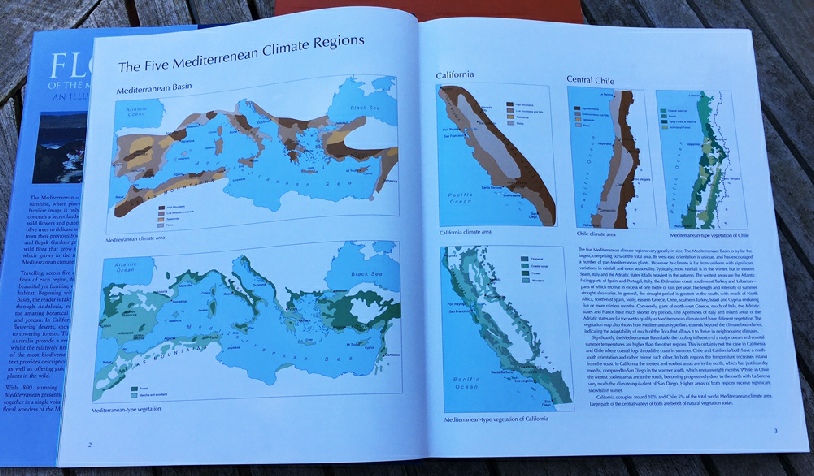
Some of the Mediterranean climate regions
Between them they boast at least 50,000 known species, many endemic. The authors have selected just 600 for their 800 exquisite photographs and explain why in detailed captions, giving each space to thrive in its habitat, often including magnificent pictures of wider landscapes too. A clear introduction to each region, geography, geology and unique characteristics sets us up for the details to follow. This glorious book can help us travel far and wide in our Covid-frustrated minds.
There are many images to jolt thinking about species that we assume we know, but perhaps not sufficiently. For instance, as a child I instinctively disliked Monkey puzzles (Araucaria araucana) in suburban gardens and even growing in Kew because they seemed ‘awkward’ (what did I know, just because they seemed a challenging climb?). There are 14 species in the genus across S America, New Caledonia and Australasia. And learning of them in southern Chile’s reserves it is clear these prehistoric umbrella evergreens are most loftily beautiful in the forest mist (yes, rather different from suburban fume-filled drizzle), 50-metre-high visions of hopefulness dotted about, overseeing shrubs and orchids and more below.
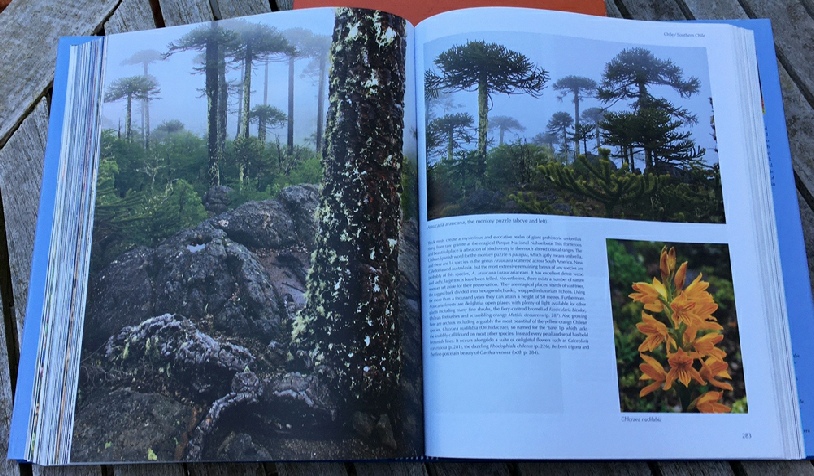
Araucaria araucana growing in Chile
Learning details of plants, familiar and unknown, in their own native habitat is a huge illustrated plus, when so many other volumes (albeit with fine photographs) offer only close-ups and brief identification. Also, many plant locations are named, photographic dates often as well.
Equally ignorantly, before visiting South Africa, in Britain Proteas seemed to be predictable ‘hotel reception flowers’ often accompanied by showy kniphofia, which often they still are. The magnificent King Protea (Protea cynaroides) is the famed national flower, one of 115 Protea species. They are only some of the glories of the fynbos of the Western Cape landscape, along with Ericaceae, Fabaceae and Restionaceae.
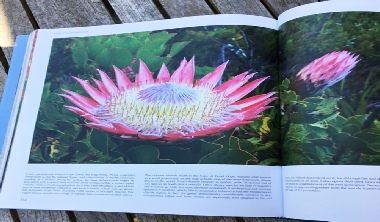
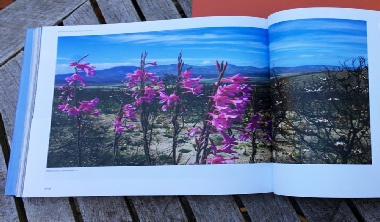
| Protea cynaroides | Watsonia borbonica |
All survive despite poor nutrients, their lateral roots grabbing what is suddenly available in the brief rains. Then there are over 2000 species of geophytes (bulbs, corms, rhizomes, tubers), only a tantalising few of which can be included. The importance of fire and ants in regeneration is clearly discussed. We are reminded that the Western Cape may be the smallest Mediterranean climate region yet it is the richest temperate flora in the world for its size (8,500 species, 68% endemic, many very localised thanks to the varied micro-climates).
As for the south-west Western Australia, and southern South Australia, the authors speak of their ‘intense bombardment of new species’, with the south-west particularly diverse. All the familiars are included – banksias, eucalyptus, callistemon, drosera, and more besides.
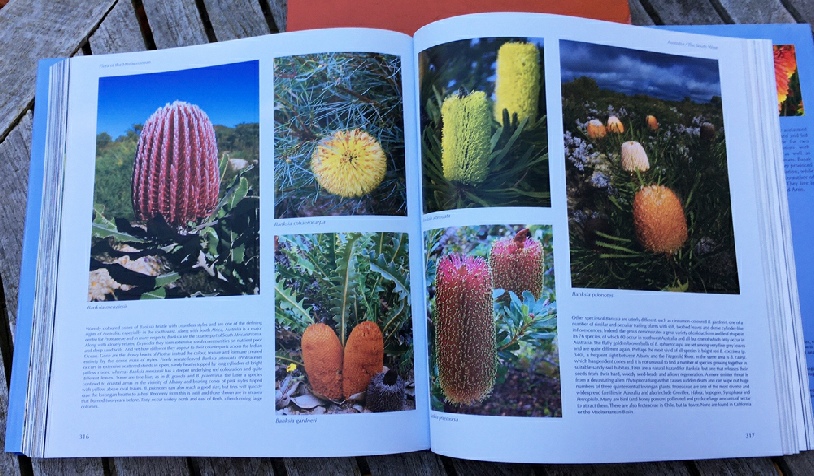
Banksias
We are told of pollinating techniques, fire and ant activity, and are reminded of the Aboriginal people’s profound understanding of sustainable management of their lands, including intermittent selective small fires, compared with more recent clumsy unintended efforts that made frightening headlines.
In the California section, the coast and sierras, and the southern deserts, are described separately, although obviously there is species overlap. More stunning photographs of the incredible variety of plants, from giant redwoods (the largest organism on earth), to oaks, pines, lupins, sagebrushes, and let us not forget numerous seasonal annuals. I long to be walking beneath groves of my favourite Cornus nuttalii with its fabulous creamy-white flowers (actually bracts), apparently profuse in northern California and the Sierra Nevada.

California has around 20 species of Fritillaria
And finally, to the Mediterranean Basin, the largest area with a Mediterranean climate and some 25,000 species of plants in its varied topography. After exotic travels in the other regions, turning the pages here feels a bit like coming home, suddenly among close friends. I am back in Petra and Wadi Rum with brilliant botanical guide, Oron Peri, finding black iris species with their extraordinarily complicated markings to trick pollinators. Wonderful tulips, anemones, iris, cyclamen, more. Or later in autumn in the Peloponnese after the first rains with John Fielding among his favourite euphorbias, snowdrops, cyclamen, olive trees, planes, oaks and cistus. It is a joy to have the memory jogged like this.
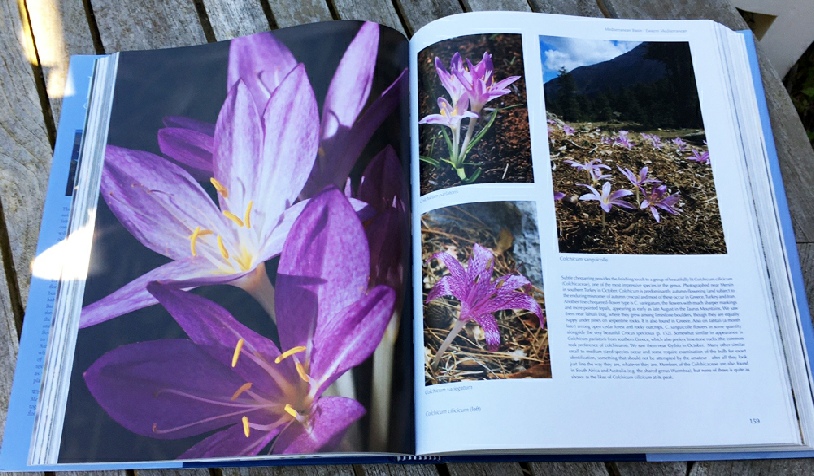
Colchicums in southern Turkey
As I said, no praise for this inspiring and beautifully designed book is too high. It is one I shall enjoy again and again.
Review by Juliet Walker – Mediterranean Plants and Gardens
Images by Chris and Başak Gardner, from the book
